Demand - Economy | SSC CGL Tier 2 - Study Material, Online Tests, Previous Year PDF Download
Meaning
Demand arises when a customer expresses a desire for a specific commodity at a given price, indicating their readiness to make a purchase in a market where prices may vary over a specific period. Therefore, demand can be viewed from two perspectives:
- Willingness to Buy:
- This reflects the customer's desire for the product.
- Ability to Pay:
- This represents the customer's purchasing power to afford the price of the desired commodity.
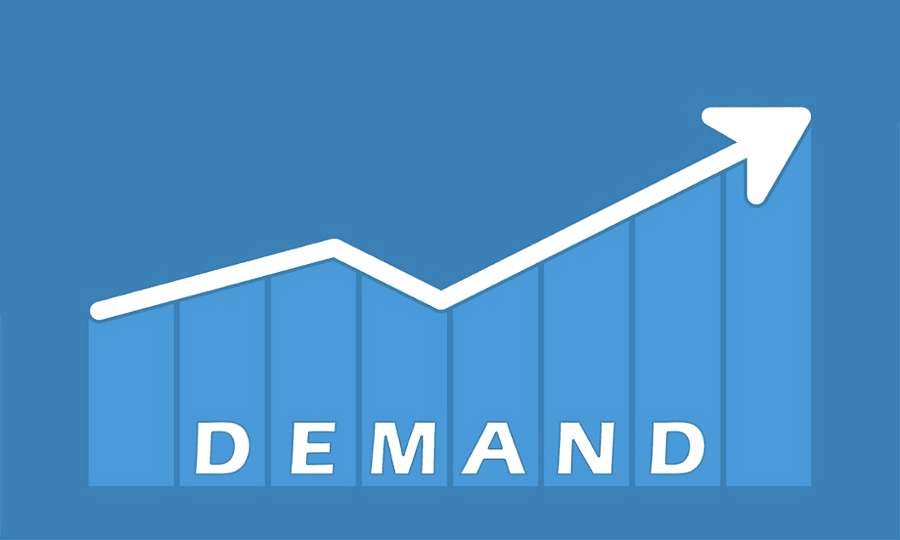
The level of customer demand is contingent upon their individual needs and preferences. Consequently, to stimulate demand in the market, the following factors are crucial:
- Desire for the Commodity:
- The customer's inclination towards the product.
- Means to Purchase the Commodity:
- The resources or capability to acquire the commodity.
- Willingness to Use those Means for Purchasing the Commodity:
- The customer's readiness to utilize their resources for acquiring the desired commodity.
Types of Demand
- Individual Demand:
- Definition: The quantity of a product needed by a single consumer at a specific price and time.
- Influencing Factors: Price, individual income, and personal preferences.
- Example: Mr. A demands 200 units per week of a product priced at Rs.40.
- Market Demand:
- Definition: Aggregate demand for a product by all individuals at a fixed price and time.
- Calculation: Sum of individual demands when other factors remain constant.
- Example: Five consumers' monthly consumption of mustard oil totaling 150 litres.
- Organisation Demand:
- Definition: Demand for a product produced by a specific organization at a set price within a period.
- Example: Demand for Maruti Suzuki cars as an instance of organizational demand.
- Industry Demand:
- Definition: Total demand for products from all organizations within a specific industry.
- Example: Cumulative demand for passenger cars from various manufacturers like Maruti Suzuki, Toyota, etc.
- Income Demand:
- Definition: Eagerness of an individual to purchase a specific quantity at a given income level.
- Autonomous and Derived Demand:
- Autonomous Demand: Independent demand not relying on other products.
- Derived Demand: Demand for a product influenced by the demand for associated products.
- Price Demand:
- Definition: Quantity of a good or service an individual can buy at a given price point.
- Perishable and Durable Goods Demand:
- Perishable Goods: Single-use items like coal, petrol, and food products.
- Durable Goods: Reusable items like clothes, shoes, machinery, and cars.
- Cross Demand:
- Definition: Demand influenced by the price of similar products.
- Example: Increase in coffee price leading to increased demand for tea.
- Seasonal and Long-term Demand: -
- Seasonal Demand: Short-term demand for products used in specific seasons. - Example: Umbrellas or raincoats sold mainly before or during the monsoon. -
- Long-term Demand: Demand for products over an extended period, influenced by factors like technology and substitutes.
Demand Schedule
Demand schedule definition is that it represents a table that portrays the quantity demand of a product at various price points. It consists of two columns, the first one lists the price and the second one displays the aggregate demand. Below is a format of the demand schedule for reference.

Demand Curve
Demand curve definition is that it is a graphical presentation of the relationship between a product’s price and its demand in a specific period. Typically, the price of a product appears on the vertical axis and the demand on the horizontal axis.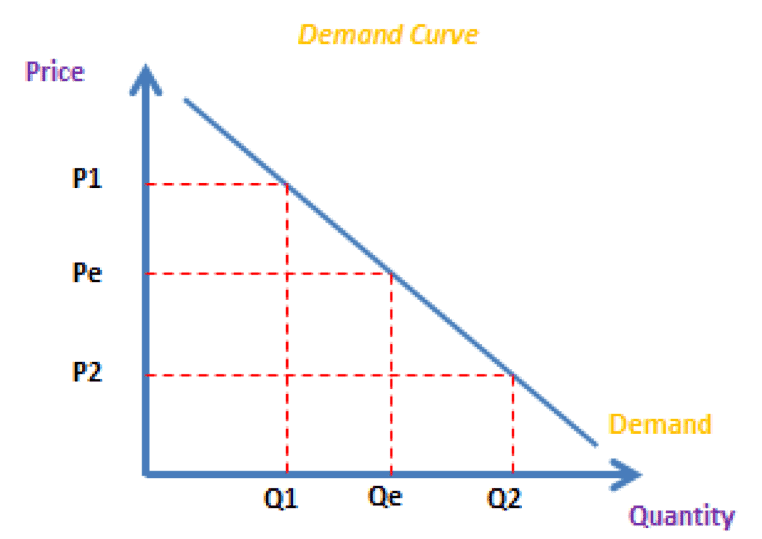
Law of Demand
The Law of Demand dictates that an increase in the price of a commodity results in a decrease in customer demand for that particular product. Conversely, when the price of the commodity decreases, there is an associated rise in the demand for it.
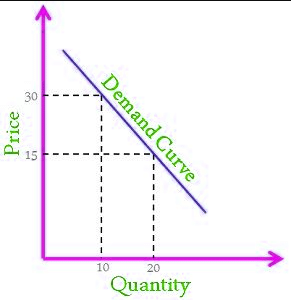
In the above diagram, the vertical axis is the price of the commodity, and the horizontal axis is the quantity demanded for the commodity. The demand curve indicates the inverse relationship between the quantity and price of the commodity.
Factors Affecting Demand
- Income Effect:
- Price drop → Real income increase → Greater purchasing power.
- Amplifies quantity demanded.
- Substitution Effect:
- Price decrease → Relative affordability.
- Consumers switch to more economical options, boosting demand.
- Diminishing Marginal Utility:
- Lowering price → Maximize utility.
- Consumption increase → Diminishing satisfaction per unit.
- Drives up demand.
- Consumer Preferences and Tastes:
- Preferences impact willingness to purchase.
- Shifts in demand curves with changing preferences.
- Indicates altered consumer behavior.
Significance of Law of Demand
- Price Elasticity of Demand (PED):
- Measures the responsiveness of quantity demanded to changes in price.
- Crucial for businesses in predicting and adapting to consumer reactions to price fluctuations.
- Significance for Businesses:
- Enables businesses to anticipate and strategically adjust prices based on consumer behavior.
- Facilitates informed pricing decisions to maximize profits and market share.
- Policy Implications Using the Law of Demand:
- Governments utilize the Law of Demand to craft effective policies.
- Subsidies are employed to decrease prices, stimulating demand, whereas taxes can deter demand by elevating prices.
- Market Insights and Strategies:
- Businesses leverage the Law of Demand for market analysis.
- Guides the formulation of optimal pricing strategies and aids in forecasting product demand.
Exceptions to Law of Demand
Some products exhibit an upward-sloping demand curve, deviating from the typical inverse correlation between price and quantity.
Two notable exceptions are Giffen Goods and Veblen Goods.
- Giffen Goods:
- These are inferior products, constituting a significant portion of a consumer's income with limited alternatives.
- Coined by Scottish economist Sir Robert Giffen in the 19th century.
- Challenge the law of demand as their prices increase with rising consumer demand.
- However, empirical evidence supporting the existence of Giffen goods is limited.
- Veblen Goods:
- Luxury items that defy the law of demand.
- Named after American economist Thorstein Veblen.
- Expensive items reflecting social and economic status.
- Demand for Veblen goods increases as prices rise.
- Examples include luxury vehicles, costly wines, and high-end clothing.
Determinants of Demand
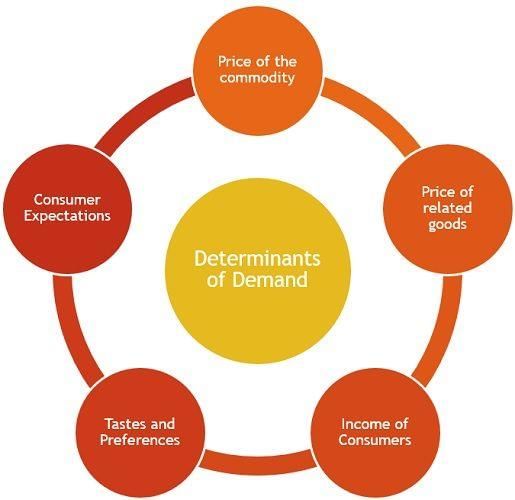
- Price of the Commodity:
- An inverse relationship exists between the price and demand of a commodity. A rise in price leads to a decrease in quantity demanded.
- Price of Related Commodities:
- Complementary Commodities:
- Items consumed together, like shoes and socks or a smartphone and its cover. An increase in the price of one commodity results in a decrease in the demand for the other.
- Competing Commodities or Alternatives:
- Items consumed to fulfill the same need, such as soap and body wash or notepad and notebook. An increase in the price of one commodity boosts the demand for its alternatives or competitors.
- Complementary Commodities:
- Income of Consumers:
- The quantity demanded is closely tied to the purchasing power of consumers. Higher consumer income correlates with a greater quantity demanded.
- Consumers' Tastes and Preferences:
- Evolving over time, consumer preferences influence demand. Trending items typically experience higher demand compared to outdated ones.
Advantages of the Law of Demand
- Price Setting Guidance:
- Helps sellers set prices for their products.
- Predictive Insights:
- Informs sellers about the expected impact on consumer demand with changes in pricing.
- Policy Relevance:
- Crucial for finance ministers as it guides decisions related to tax rates, influencing the pricing and consumer demand for various goods.
Limitations of the Law of Demand
- Contextual Inaccuracy:
- In certain situations like war, depression, Giffen paradox, speculation, ignorance effect, and basic needs, the law may not accurately predict consumer behavior.
- Exceptional Events:
- During anticipated wars, people may stock up on goods despite rising prices, challenging the law's applicability.
- Assumption Dependency:
- The law may not hold if the underlying assumptions are false in specific circumstances.
Change in Demand
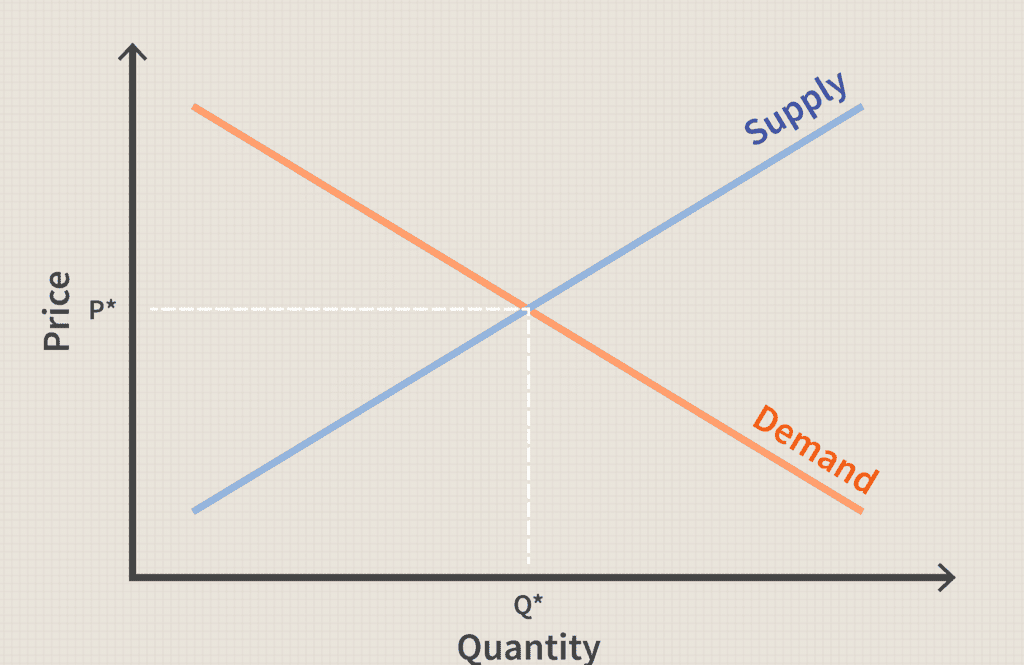
The change means an increase or decrease in the volume of demand and supply from its equilibrium. There exist some determinants other than the price of the commodity which affects the quantity of demand, like the income of consumers, the taste of consumers, preference of consumers, population, technology, etc.
Factors Influencing Changes in Demand:
It is crucial to distinguish between a change in quantity demanded, a movement along the demand curve, and a change in demand, a shift in the demand curve. While a change in the quantity demanded of good X is solely driven by a change in the price of good X, there are multiple reasons for a change in demand for good X, including:
Changes in the Price of Related Goods:
- Substitutes and Complements:
- Substitutes (e.g., margarine for butter) impact demand as their prices change.
- Complements (e.g., shoes for shoelaces) also influence demand based on price fluctuations.
- When goods are substitutes, an increase in the substitute's price boosts demand for good X, shifting the demand curve right, and vice versa.
- In the case of complements, an increase in the complementary good's price decreases demand for good X, shifting the demand curve left, and vice versa.
- Substitutes and Complements:
Changes in Income:
- Normal Goods:
- As incomes rise, the demand for a good generally increases at all prices, shifting the demand curve right.
- Conversely, a decrease in income leads to decreased demand and a leftward shift in the demand curve.
- Inferior Goods:
- Some goods exhibit an inverse relationship with income changes.
- For example, as incomes increase, people may demand more meat and fewer potatoes, making meat a normal good and potatoes an inferior good.
- Normal Goods:
Shifts in Preferences:
As individuals' preferences for goods and services evolve, the demand curve for these commodities undergoes a shift. For instance, with the surge in gasoline prices, consumers in the automobile market have shown an increased preference for fuel-efficient "economy" cars over gas-guzzling "luxury" cars. This shift in preferences is illustrated by a rightward movement in the demand curve for economy cars and a leftward shift for luxury cars.
Changes in Expectations:
Expectations can also prompt shifts in demand curves. For instance, if buyers anticipate long-term job security, they may be more inclined to purchase goods like cars and homes, which involve extended payment periods. Consequently, the demand curves for these goods shift to the right. Conversely, in an economic climate marked by job insecurity, such as during a recession, buyers may reduce their demand for goods with long-term payment commitments, causing a leftward shift in the demand curves for these items.
|
1335 videos|1433 docs|834 tests
|
FAQs on Demand - Economy - SSC CGL Tier 2 - Study Material, Online Tests, Previous Year
| 1. What is the meaning of demand in the context of the economy? |  |
| 2. What are the different types of demand? |  |
| 3. What is a demand schedule and how is it used? |  |
| 4. What is a demand curve and how is it derived? |  |
| 5. What is the law of demand and why is it significant? |  |
















